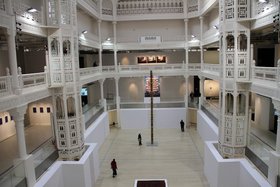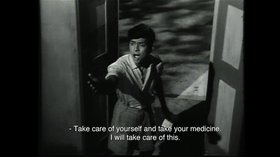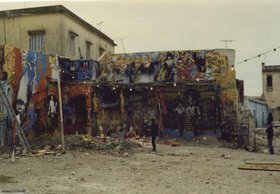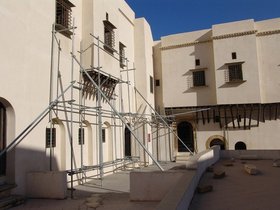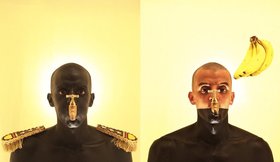Essays
Productive Contexts and Contemporary Restraints
The Practice of Contemporary Art in Algeria Today
In this essay for Ibraaz, writer and critic Alice Planel explores the conditions of artistic production in Algiers, a city still affected by the legacy of a devastating civil war in the 1990s. Taking the third FIAC Algiers (2011) as her starting point, Planel references some of the key players promoting, discussing and exhibiting contemporary art in the Maghreb and talks to Algerian artists including Amina Menia and Atef Berredjem about how they develop their practices and negotiate the many difficulties inherent in getting their work produced and displayed. In doing so, Planel reiterates the need for scholarship on the subject of contemporary art in Algeria and across the Maghreb, and explores some of the tensions arising therein between the traditional and the contemporary. Due to discriminatory uses of the word 'modernity', she argues, it is also the very taxonomy and history of modern art that inhibits analyses of modern or contemporary Algerian art.
PRODUCTIVE CONTEXTS AND CONTEMPORARY RESTRAINTS: THE PRACTICE OF CONTEMPORARY ART IN ALGERIA TODAY
On 3 December 2011, the third FIAC (Foire Internationale d'Art Contemporain) of Algiers opened at the MAMA (Musée d'Art Moderne d'Alger), with a programme that perhaps exceeded its initial purview. In other words, there was a disjuncture between the event's scope and its actual effects. This disjuncture is revealing of the context of art production and exhibition in Algeria today, as I will map out in the following article. The realm of Algerian art is not my field of study per se and I thus refer to the testimonies of artists working in Algeria as far as possible. Whilst I have only visited Algeria twice, as a contributor to a conference and then as a researcher, I am in regular contact with several of Algeria's key creative actors.
The MAMA is an institution in its infancy and yet, after a long period of cultural and intellectual instability linked to the Civil War, it fronts efforts to support the practice of art within the country. The idea of a modern or contemporary museum of Art for Algiers dates back to the independence of the country in 1962 but such plans were shelved as the government instead invested in public art to inspire the new nation. Several galleries dedicated to contemporary and modern art did open, but faced with tactics of intimidation and assassinations directed against intellectuals and artists during the Civil War they subsequently closed. The alternate opening and closure of cultural and artistic institutions in the capital in the last century is revealing of a tide-like ebbing of cultural life determined by periods of colonization, independence and civil war that has marked Algeria's recent history. Today, art galleries that do open have a short life span as they are often the project of individuals with disposable capital but little experience or knowledge. They close for being commercially unviable and incompetently run, confirms the artist Amina Menia, a perspicuous observer of Algerian cultural politics.[1]
It is in such a context that the MAMA opened, and remains so. The MAMA is an open and welcoming space constituted of a soaring hall with three tiers of balconies, centrally located on a leafy street. Its white interior is symptomatic today of exhibition spaces of modern and contemporary art. Nonetheless, and despite the institutional character of its white windowless walls, it is a flexible space that can be adapted to the exhibition of different media. As Menia writes, we need now to give the institution more independence and financial support.[2]
A triumphant Mohammed Djehiche – the gregarious director of the MAMA – announced at the conference of the FIAC that the catalogue was published in time. This was no mean feat. Nevertheless, the catalogues turned out to be as rare as they were coveted and I could not bring a copy back to the UK. Laboriously produced, the MAMA catalogues are not available outside of Algeria, and occasionally not even within the country. The quality of reproductions in exhibition catalogues, or mistakes in the referencing of images, directly affect art historical analyses; it is thus a substantial problem that there is seemingly no specialized and thus competent art publishing house in Algeria. Furthermore, that these catalogues are not available to scholars abroad limits the scope of research on Algerian art. The MAMA catalogues are essential, for there is no dedicated platform for the exchange of artistic ideas within Algeria and for the interpretation of what is exhibited and produced for the benefit of the population. Important cultural events are usually reported in the national and local press but there is a definite lack of specialized criticism or art press in Algeria and there is thus little production of knowledge with regards to either modern or contemporary art.[3]
This brings us on to the theoretical underpinnings of contemporary practices and the historicization of Algerian art. During her paper given in Algiers, Rachida Triki, a professor of Aesthetics and Philosophy of Art at Tunis University, decried a lack of art history in the Maghreb, a fact echoed by art professionals and practitioners across the region. Indeed, there is no department of art history at the University of Algiers. Practical and theoretical tuition is dispensed at the Ecole Supérieure des Beaux Arts Algiers, and the regional schools of Tipaza, Batna and Annaba. However, the teaching remains focused on easel painting and drawing, and harks back to Algerian modernist movements. Hence, successive generations of artists are not encouraged to contextualize contemporary practice within the history of Algerian art. In the volume edited by James Elkins, Is Art History Global?, several contributors discuss the fact that for many countries of the African continent, art historical scholarship is written in western institutions.[4] That said, in the case of the Maghreb and Algeria especially, scholarship is even limited abroad. That contemporary Algerian art is often forgotten on the touch-line of the global art playground is to a great extent due to the silence on modern Algerian art in art historical scholarship across the globe.
Elkins goes on to argue that even within this age of transnationality, art history remains politically and culturally located.[5] How art history is written and what is written is subject to political and cultural contexts, as demonstrated by the very limited scholarship on Algerian art written to this date in institutions across Europe and the US.[6] The pioneering research of Malika Dorbani Bouabdellah and Ramon Tio Bellido finds little echo in contemporary scholarship.[7] This absence or amnesia is partly due to diplomatic or political tensions, and in the case of France, to sensitive cultural memories. It is also due to discriminatory uses of the word 'modernity'. In other words, it is also the very taxonomy and history of modern art that inhibits analyses of modern or contemporary Algerian art.
Katarzyna Pieprzak's study of the importance of festivals of culture in Morocco demonstrates that Moroccan Modernism asks to be situated differently.[8] Pieprzak draws on Frederick Cooper and Paul Rabinow's definition of modernity as a 'native's category', specifically Cooper's suggestion that modernity is a 'native's' – that is, localized – and, more problematically, an 'analytical' category. As a category of analysis that is localized, he asks that analyses of the modern not dictate our perception of divergent practices but rather invert them: let practice define theory. Katia Kameli's recent video commission for the Higher Atlas exhibition of AiM 2012 is indicative of this process of letting practice dictate analyses of modern cultural expressions. Storytellers (2012), filmed and then exhibited in the inner shell of the National Theatre, features a storyteller from the Djema el Fna known for the way in which he weaves together Moroccan narratives with others lifted from modern Bollywood films. The theatre itself is unfinished – work having been abandoned when architectural calculations were found to be erroneous. However, as Kameli suggests, the theatre also lies unfinished because the need for an Opera in Marrakesh is not felt. The city already has a live tradition of public spectacle in its main square that testifies to myriad experiences of modernity. Set within the raw concrete sanctum of the National Theatre, Kameli's video demonstrates how short-sighted it is to insist on unilateral definitions of contemporary or modern culture. Indeed, instead of battling with definitions of modernity, Cooper writes, scholars should instead 'hear what is being said and why', since 'shoehorning' different conceptions of modernity or postmodernity is illusory.[9] Cooper does not, however, advocate the idea of plural modernities: to the extent that an understanding of colonialism within the context of modernity problematized notions of Africa having to 'catch up [with] the west', he argues, it is reductive to consider western and non-western modernity as incommensurable.[10] I would likewise argue that it is ill-conceived or regressive to expect nations or communities to be 'authentic', and that analyses of the 'modern' serve to reveal how communities or cultural artefacts continue to be historicized from western perspectives.[11]
As a representation of modernity, modern art is thought to be determined by economic and technological progress. The Maghreb's limited industrialization means that countries such as Tunisia and Morocco are seen as lands of unsurpassed tradition and artisanship in western collective imaginations. Thus, it is often overlooked that Maghreban art of the twentieth century presents defining aspects of modern art, such as the invention of original form and technique, which references art history and changing socio-political agencies. The work of Aouchem artists Choukri Mesli and Denis Martinez, whilst inspired by French 'Abstract Lyricism' and 'New Realism', drew on 'signes magiques' (magic signs) that they argued were kept alive in the Algerian national subconscious throughout the colonial period. Their work is thus the expression of experiments in paint and form, as well as changed social, political, and cultural realities in Algeria after its independence. The art world's pathological desire for art to be cutting-edge disallows events such as Moroccan festivals of culture to be considered valid 'chronoposts', or markers in the history of modern art, in the development of art and culture. It is beyond doubt that new meaning is produced within the performance of a more ritualized expression of culture such as that which can be found in Moroccan festivals, but even the most ritualized form played out in a public setting enacts changed social experience, bringing about new forms of cultural and artistic experience. Festivals of culture can thus be also modern and contemporary.
That the history of twentieth-century Algerian art is not written does not enable curators, academics and journalists to mediate with a local audience, simply because the knowledge to be communicated is not produced. However, as I will observe in what follows, we should not demand of Algerian artists to necessarily interact with a local public; to make that bridge is surely the role of art professionals.We return once again to the conference at the FIAC. The audience present strained to listen to the staccato translations, even bilingual listeners struggled to hear above the din outside the Galerie Mohamed Racim where the conference took place. Responding to the situation we found ourselves in, Marko Stamenković asked during his performative presentation that we embrace the noise from the streets, for that is where our public is. His suggestion served to underline the fact that international and national experts and artists present were discussing future exhibitions of art in the name of a diverse public that we, as an audience, were not necessarily representative of.
Do we ignore the demands of this diverse public, just as we strived to ignore the noise outside the gallery? Whilst I agree with Stamenković's point, there is too much emphasis placed on the ability of art professionals to respond to the needs of local populations in non-western regions. The 2012 Marrakech Biennale, for example, was criticized for not involving local populations.[12] However, we must not forget that institutions across the globe find this to be very challenging. Indeed, our answer to this problematic in Europe and the USA is what Jean Baudrillard classed as the 'cultural hypermarket': a series of crowd-pleasing, blockbuster exhibitions. To return to Algeria, whilst it is true that audiences are more unknowing of contemporary art than audiences in the UK for example – where blockbuster contemporary art shows are regularly reviewed in newspapers, on television and on the radio as well as in a diverse art press – the very taxonomy of contemporary art is out of touch with a large percentage of populations the world over. This problem is therefore global; a fact to keep in mind as we analyse the resonance or concrete effects of events such as the FIAC in Algeria.
That the art world, a generalized term I know, is also out of touch with the reality of its own systems and practices is also germane – a point that is nowhere more apparent than with celebratory discourses on global art. Whilst the art market today has a greater sphere of influence and curators turn towards new horizons in the search of art to exhibit, it remains to be debated that the art world is global.[13] Charlotte Bydler argues that whilst globalization is defined by circulation across borders, the permanence of nation-states remains. Indeed, actors of the art world are dependent on citizenship, materials and infrastructures, which in turn negate the idea of the nomadic artist.[14] Access to residency programs in places like New York, Bydler writes, is not open to everyone as most grants and national programmes are open to citizens of the same country as the funding institution, so that artists from poorer countries have less chance to be accepted into a cultural program.[15] Private institutions such as the Delfina Foundation in London do host resident artists from countries like Algeria. However, even these institutions are not able to counter strict immigration laws.
Whilst it is difficult for Algerian citizens to be granted European and US visas, the context of production in Algeria leaves many of its artists in need, as we have seen. It is all the more important to sustain communication with global art practices. I agree with Bydler that the Internet does not necessarily assure equal dissemination of information; however, online resources prove to be invaluable for Algerian art practitioners. Across generations, I have found that artists are aware of what is being produced in different artistic centres across the globe and demonstrate enthusiasm for myriad forms of contemporary art. And yet, the fact that the 'Beaux Arts' art school in Algiers produces such 'ovni' (or UFO), as I have often heard the artist Adel Abdessemed be referred as, is in great part due to Nadira Laggoune, curator of FIAC and tutor at the Art Academie in Algiers. Laggoune's wide expertise and the dedication of her students to the 'nouveaux médias' (new media) course, sees them using web resources to form a dialogue with art practices across the globe. Amina Menia, whose practice includes ephemeral installations and site-specific work, confides in her feeling of artistic solitude while testifying to the fact that there are many artists practicing in Algeria today. 'It would seem that my practice is misunderstood, and therefore is not echoed by other artists. I need to rub shoulders with other artists, to have REAL debates, tangible suggestions, [so as] to compare myself'.[16]
The present Minister of Culture Khalida Toumi, along with her team, has given her support to such events as FIAC and, despite being restricted by a lack of web and archival presence, will hopefully have a long term impact on developing artistic practices in the country. However, the investment of the Algerian government remains limited and there is no dedicated, sustainable private or corporate patronage for the arts. Collectors do not take risks, and invest in Orientalist painting or modern art that has recognition such as Baya or Issiakhem. This means that artists depend on alternative sources of income throughout their career, with the occasional commission from foreign institutions. The artist Ammar Bourras was commissioned to produce a piece of work for the 2011 Sharjah Biennial on a scale he previously had thought impossible. Atef Berredjem did benefit from a small grant to develop his work but he funds his practice by teaching at an art school. Menia, who appeared on the cover of the magazine Modern Painters for an article on the 100 contemporary artists to watch, and who has shown work at the gallery Anne De Villepoix in Paris, is studio-less and struggles to bring her work to fruition. She says: 'For [my work] Extra-Muros, I wanted to inhabit the streets, public spaces, avoid consecrated spaces. My installations were to be ephemeral, self-produced, self-financed. To answer to the fact that I have no studio, nowhere to store materials, no means to finance equipement, etc. ... I produce ephemeral sculptures, demountable, that necessitate no storage and no upkeep'.[17]
In addition to these already fraught issues, artists often talk of the administrative restrictions of producing art. Gaining permission to install work or shoot footage outside, Berredjem told me on several occasions, is difficult and for many artists discouraging. There are also cultural and political limitations to artistic production, Berredjem writes. 'Artistic production is a domain controlled by the governmental administrations even if these past years one can express oneself more freely. In parallel, there are also difficulties that are cultural or traditional in nature, in other words: difficulties in finding a female character for a film, a character for a work deemed political'.[18] Near the port of Algiers and in the area of Belcourt, huge spaces could be turned into studios, cultural centres or exhibition spaces. However, administration offices are suspicious of most endeavours and real estate rates are unfathomably high. Nevertheless, structures devoted to the promotion and creation of art and culture do exist: the organization Chrysalide, for example, is assisting the London-based artist Zineb Sedira in concretizing the work she has been doing for many years bringing the work of fellow Algerian artists to the attention of critics, curators and academics in Europe, by launching the residency project A.R.I.A (Artist Residency in Algiers).
As a concluding note, I hope this essay explains how the vibrant atmosphere at the FIAC is not the product of a consecration of artistic practice within the country, but is intrinsic to the energy of its leading figures and the quality of the work produced by some of its young practitioners. The commitment by such influential figures as Bartolomeo Mari, Simon Njami, Gabriela Salgado, Rachida Triki, Kaelen Wilson-Goldie, Aaron Cezar and Delfina Entrecanales from the Delfina Foundation, who despite discouraging visa processes attended the opening conference in Algiers, testifies further to the deserved interest that Algiers is beginning to attract. Sometimes it is only by punching above one's weight that a place in the ring can be secured.
[1] Email conversation with the artist, April 2012
[2] Ibid.
[3] European publications routinely consider a 'crisis of criticism'. It is true that there is no training for art critics in European and US institutions, and that critics in the art press, successful in prolonging artistic concepts, struggle with making themselves intelligible to a wide audience. However, this 'crisis of criticism' is perhaps one of overproduction than absence.
[4] James Elkins, ed., Is Art History Global? (New York and London: Routledge, 2007), 9.
[5] Ibid., 9.
[6] Elkins' emphasis on the difference between publications on theory and that on practice makes apparent the problem that the little scholarship there is, as valuable as it may be, is not located within the field of art history or visual studies but within that of postcolonial theory.
[7] Ramon Tio Bellido, ed., Le XX Siècle dans l'Art Algérien (Paris: Aica Press, 2003); Malika Dorbani Bouabdellah, 'La guerre d'Algérie et les Arts Plastiques' in La Guerre d'Algérie: 1954-2004, La Fin de L'Amnésie, eds. Benjamin Stora and Mohammed Harbi (Paris: Editions Robert Laffont, 2004); and Malika Dorbani Bouabdellah, 'La Peinture en Algérie à la Recherche de son Style' in Le XX Siècle dans l'Art Algérie, ed. Ramon Tio Bellido (Paris: AICA Press, 2003).
[8] Katarzyna Pieprzak, Imagined Museums: Art and Modernity in Postcolonial Morocco (Minneapolis and London: University of Minnesota Press, 2010).
[9] Frederick Cooper, Colonialism in Question: Theory, Knowledge, History (Berkeley: University of California Press, 2005), 115.
[10] Ibid., 133.
[11] 'The interconnection - and commensurability - of different parts of the world is not only a historical fact but a resource, for good, for bad, and for much that lies in between', writes Cooper. Ibid., 139.
[12] What the Marrakech Biennale can be criticized for is the misuse of a phenomenon succinctly theorized by Pieprzak, and which we have already discussed, as that of the festival. Instead of being a living event, the Fantasia and the singing circles that were scheduled became closed quotations nearly as problematic as the Zulu dancers that reportedly opened the exhibition Magiciens de la Terre in Paris 1989 (I could not be there myself as I was seven years old at the time).
[13] To be more precise: is it global in the sense that it self-professes: as an exercise in diversity of meaning and greater understanding across the globe, and not in the neo-liberal economic sense of a free-market, corporate-driven economy - which it could be argued it is.
[14] Charlotte Bydler, The Global Art World Inc: On the Globalization of Contemporary Art (Uppsala: Uppsala University Press, 2004), 33.
[15] Ibid., 55.
[16] ('Il semblerait que ma pratique soit peu comprise, et ne reçoive donc pas d'&eacte;cho de la part des autres artistes. J'ai besoin de me frotter aux autres artistes, d'avoir de VRAIS débats, de vraies propositions. Me comparer'.) Email conversation with artist, April 2012.
[17] (Pour Extra Muros, je voulais aller dans la rue, dans des espaces publics, éviter les espaces consacrés. Mes installations devaient être éphémères, auto-produites, auto-financées. Pour répondre au fait de ne pas avoir d'atelier, pas d'espace de stockage de matériel, pas de quoi financer un équipement, etc ... je réalise des sculptures éphémères, démontables, qui ne nécessitent après coup ni entreposage, ni entretien'.) Email conversation with artist, April 2012.
[18] ('La création en Algérie reste un domaine très contrôlé par les instances publiques même si ces dernières années on peut exprimer en peu plus librement qu'avant. En parallèle, il y a aussi des difficultés à caractères culturelles et traditionnelles, c'est a dire, difficile de trouver une figurante pour une vidéo, un figurant pour une œuvre dite politique'.) Email conversation with the artist, March 2012.

